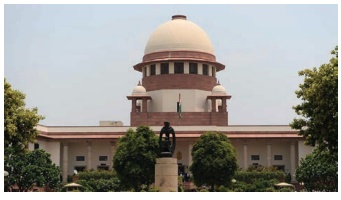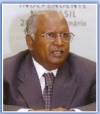Uniqueness, Sources of Law, Jurisdiction and Powers, Organization, Appointments, High Courts, Legal Remedies | Indian Judiciary | Political Science - Supreme Court of India | 12th Political Science : Chapter 4 : Indian Judiciary
Chapter: 12th Political Science : Chapter 4 : Indian Judiciary
Supreme Court of India
Supreme Court of India
Uniqueness – Sources of Law – Jurisdiction and Powers – Organization
The Constitution of India provides for a three -
tier judicial system:
(1). The Supreme Court of India
(2). The High Courts in the constituent States and
(3). The District and Sessions Courts in the
judicial districts in every state.

The Constitution also provides for an independent
judiciary i.e. independence of the Executive and the legislature. In a
democratic federal polity like India. The Supreme Court assumes a much bigger
note as the guardian of the Constitution, as an arbitrator in disputes between
States and the Union Government and in disputes among the States, and as the
highest appellate Courts in all civil and criminal cases. It is endowed with
the onerous responsibility of safeguarding and enforcing the fundamental rights
and freedoms of all citizens of India. However, unlike the federal system in
the USA, the Constitution of India of India does not provide for two sets of
judiciary (one as federal, another for States). India has only a unitary
judiciary system, with the Supreme Court as the apex Court, with authority over
all other Courts in India.
The Sources of Law : The Constitution is the fountain
source of law in India. Statutes enacted by legislatures of the union, State or
Union Territories become another source of law as long as these are in
conformity the basics of the Constitution. Besides the subordinate legislations
in the form of rules, regulations as well as by – laws of any administrative
body, unless and until negated by the judiciary constitute the third source of
law.
Integrated Judiciary
“The Indian Federation, though a dual polity, has no dual judiciary at all. The High
Courts and The Supreme Court Constitute one single integrated judiciary having
jurisdiction and providing remedies in all cases under the Constitutional law,
The Civil law or the criminal law. This is done to eliminate all diversities in
a remedial procedure”
Jurisdiction and Powers on the Supreme Court: The Supreme Court has original, appellate and advisory jurisdiction.
The original jurisdiction of the Supreme Court extends to all cases which can
originate in the Supreme Court. These include disputes between the Government
of India and one or more States, or between two or more States. In disputes
involving fundamental rights, the Supreme Courts has both original and
appellate jurisdiction. It can issue Writs of Habeas Corpus, Writ of Mandamus,
Writ of prohibition, Writ of Certiorari and the Writ of Quo warranto.
The Supreme Court is the highest or Apex appellate
Court in India, where appeals against judgments of High Courts can be made; (
in both civil and criminal cases)
The Supreme Court of India has also been vested
with certain Advisory Powers. The President can seek its advice on any
legislative measure. However, the advice of the Supreme Court is not binding on
the President (Article - 143).
The Supreme Court functions as the guardian of the
Constitution; It is the final authority to interpret the Constitutional may justify the topic and another group may disagree.
law, and has the authority to declare any law or
executive action, or judgments of lower Courts ‘null and void’ if the Supreme
Court find them against the letter and spirit of the Constitution. It is also the
apex agency to safeguard the fundamental rights listed out in the Constitution.
Debate
Topic : Justice delayed is justice denied
Justice comes slowly in smaller courts, with 2.91 crore
cases pending
v With more than 8
lakh cases pending in district and subordinate courts, Uttar Pradesh tops the
list of States with the highest number of decade-old-court cases.
v As per the National
Judicial Data Grid, there are 2.91 crore cases pending in district and
subordinate courts, out of which 21.90 lakh cases are pending for more than 10
years.
v Uttar Pradesh is
followed by Bihar, with more than 3 lakh pending cases, and Maharashtra with
over 2 lakh cases. Sikkim and Andaman and Nicobar are at the bottom with two and
no pending cases, respectively.
v Teacher can
organise a Critical Debate on “Justice delayed is justice denied”. Learners
can be divided into two groups. One group
Organization of the Supreme Court
The Supreme Court of India has been established by
Part V, Chapter IV of the Constitution of India. Articles 124 to 147 of the
Constitution lays down the composition and jurisdiction of the Supreme Court of
India. Originally the Constitution provided for the chief Justice and seven
lower ranking Judges. The Constitution enables the Parliament to increase this
number. By 2008, the number of judge have been increased (from eight) to 30. By
2019, there are 34 judges including chief justice.
As to the appointment of the Supreme Court judges,
The Chief Jostle of India should consult a “Collegium” of four senior most
judges of the Supreme Court. The Collegium makes the decision in consensus.
Every Judge of the Supreme Court is appointed by the President after
consultation with the cabinet and the Judges of the Supreme Court and such Judges
shall hold office until they attain the age of sixty five years. If any of the
judges wants to lay down office, he can do so through an hand written signed
resignation letter to the President; the Parliament can remove a Judge through
an impeachment. TO be considered for the office of Judge, one must be a citizen
of India and his qualification is per the Parliament’s decision, and the should
have been judge of High Court at least for a period of 5 years; or an advocates
of a High Court or of two or more such courts in succession for at least 10
years or the person must be, in the opinion of the President, a distinguished
jurist.
Impeachment
A Judge of the Supreme Court can be
tried by an order of the President, after an address by each House of the Parliament
supported by a majority of the total membership of that house and by a majority
of not less than two thirds of the members of the house present and voting in
the same session.
Appointments are generally made on the basis of Seniority
In 2007, Justice
K.G. Balakrishnan became the first Chief Justice of the Supreme Court
from the scheduled caste community.

The Supreme Court of India under the present Constitution commenced functioning on January 28, 1950. It was placed then in the Chamber of Princes in the Parliament. It moved to the present building in 1958.
Harilal J. Kania was the first Chief Justice of the Supreme Court. The other judges who assumed office along with him wise Justices Sayid Faze Ali, M. Patanjali Sastri, Mehar Chand Mahajan, Bijan Kumar, Mukherjea and S.R.Das.

High Courts
The High Court is the head of a State’s judicial
administration and every constituent state in expected to have a High Court.
However, at present, four High Courts have jurisdiction over more than one
state. Among the Union Territories, Delhi alone has a High Court of its own.
Other six Union Territories come under the Jurisdiction of nearby State High
Courts. Each High Court comprises of a Chief Justice and such other Judges as
the President may from time to time, appoint. The Chief Justice of the High
Court is appointed by the President in consultation with the Chief Justice of
India and the Governor of the State. In appointing other judges, the Chief
Justice of that High Court is also consulted. The Judges of the High Courts
hold office until the age of 62 years and are removable in the same manner as a
Judge of the Supreme Court. TO be considered for appointment as a Judge one
must be a citizen of India and have held a Judicial office in India for 10
years or must have practiced as an advocate of High Court.
The High Courts too have original
and appellate jurisdictions, in cases arising within the territories of the
State. Each High Court has powers of Super, intendant over all courts within its
jurisdiction. Though the High Courts are the party of single and integrated
judicial system, yet they are completely independent judicial institutions. The
Supreme Court has no direct administrative control over them, nor they are in
any way controlled try either the legislature or executive of the State. But
the Judger may be transferred from one High Court to another by the President
his consultation with the Chief Justice of India.
The High Court too has the power to issue writ in
cases involving ‘Fundamental Rights’.
Legal Remedies for Safeguarding Fundamental Rights
Both the Supreme Court and High Court have the
power to issue writs with a view to ensure quicker justice and early relief to persons
whose rights are violated. There are five such writs.
1. Habeas Corpus: Literally means a demand to produce the
person in body. It applies in cases where a person is alleged to have been
illegally detained. This writ safeguards personal liberty of every individual.
2. Mandamus is a command to act law fully and to resist
from penetrothing an unlawful act, It is meant to direct any authority to perform
its legal duty. Mandamus may he issued against any authority, Officers,
Government or even judicial bodies that tail or refuse to perform a public duty
and discharge a legal obligation.
3. Prohibition is issued by a higher Court to a lower
court or tribunal for prohibiting it from exceeding its jurisdiction. Writ of
Prohibition is issued only against a judicial or quasi – judicial body.
4. Certiorari too lies against
judicial or quasi – judicial authorities, and it
means ‘to be informed’. The writ of certiorari is issued to quash illegal
orders of judicial or quasi – judicial bodies
5. Quo – Warranto is a question asking ‘with what authority
or warrant’. This is meant ascertain the legal position in regard to claim of a
person to hold a public office.
Besides these writs, the High
Court’s under Article 226 may issue other directions and orders in the
interests of justice to the people.
Activity
Newspaper Follow-Up
Follow the
newspaper for one month and collect news items related to civil cases in the
District and Session court, High Court and Supreme Court of our country. Write
the headlines of the news in the chart. Display the chart in the notice board
or present your collections in the classroom.
Related Topics